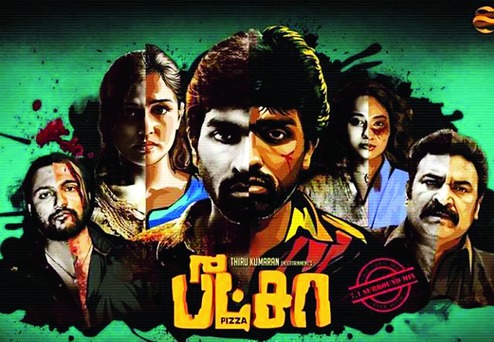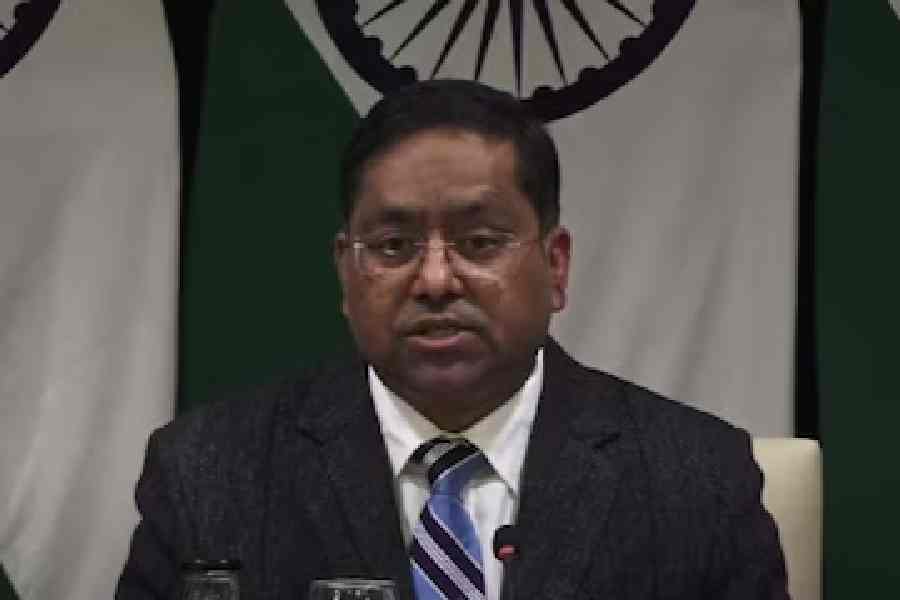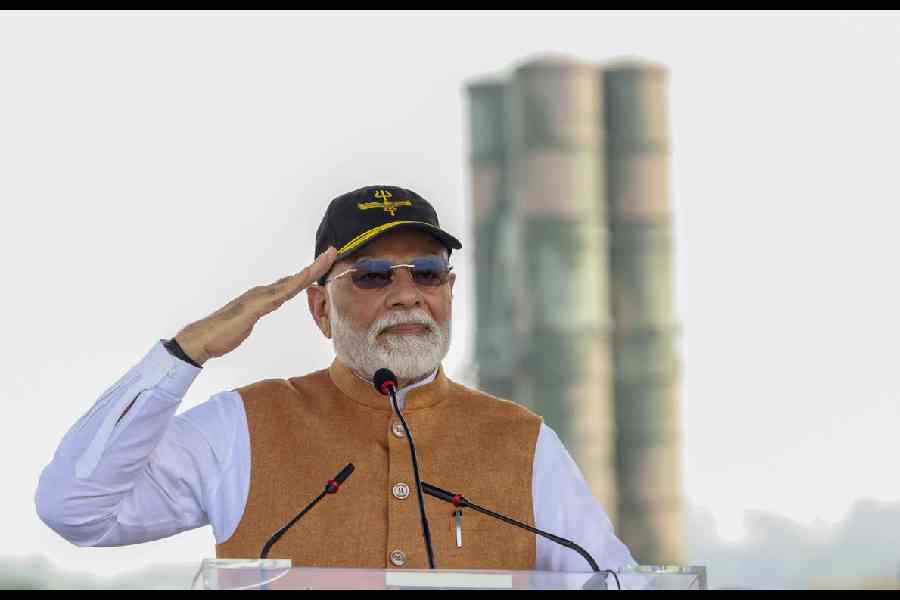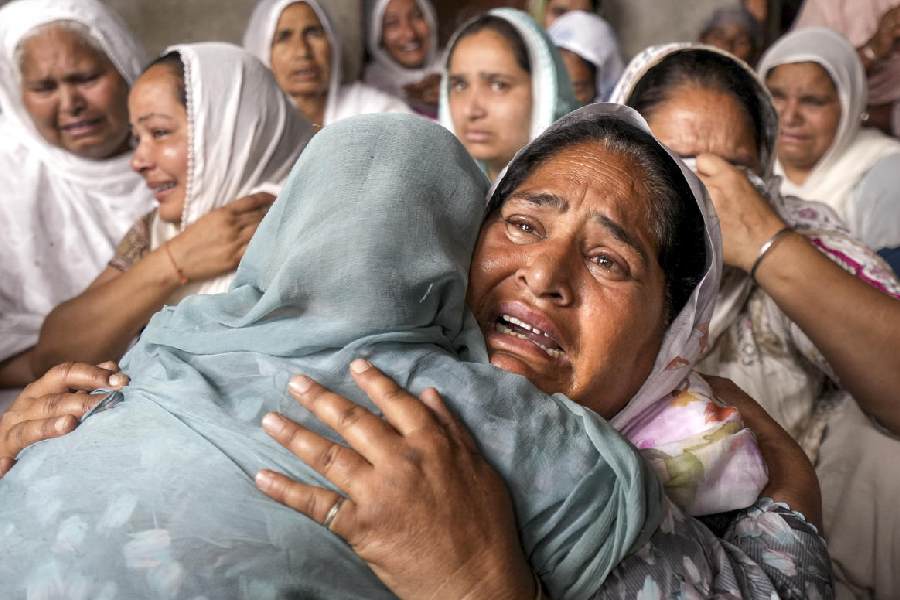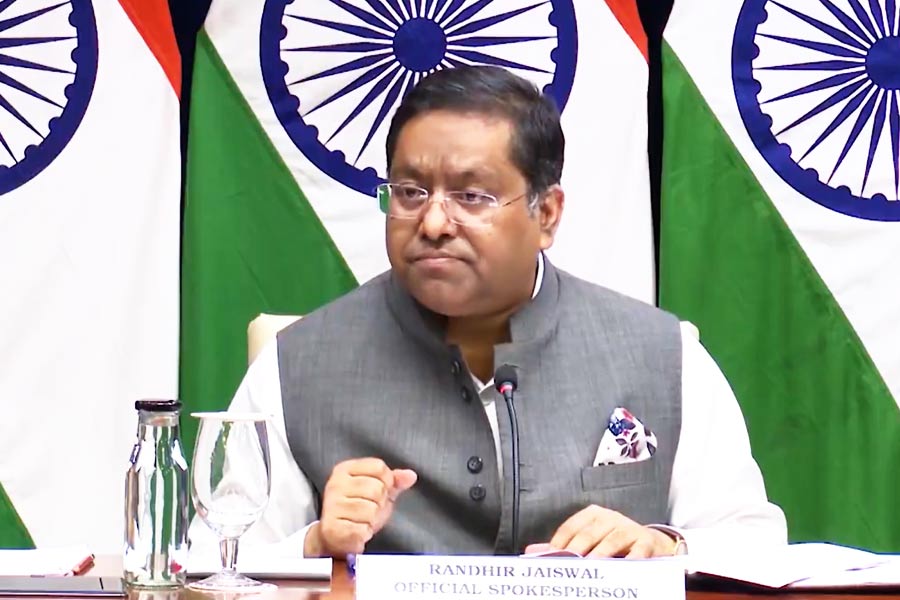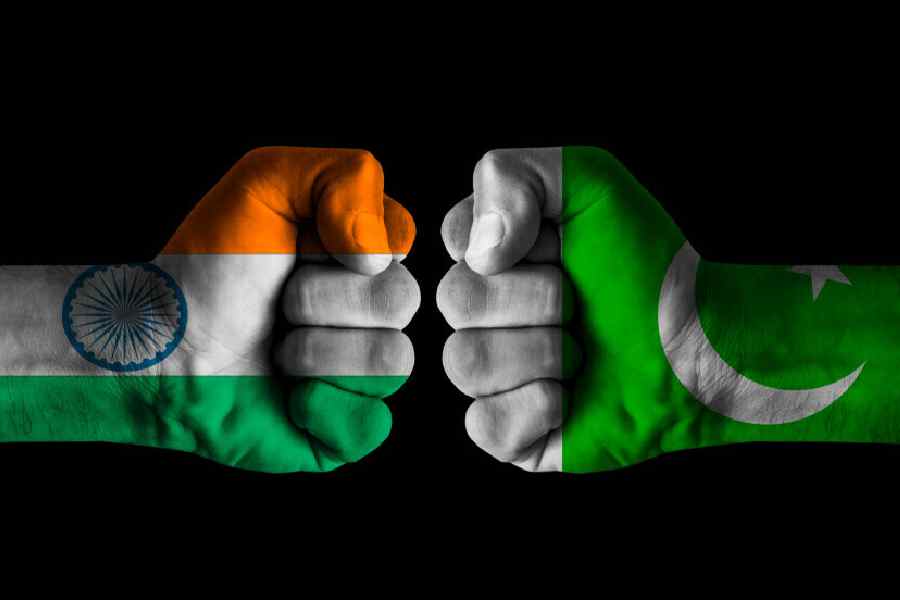You can always tell a fever way before it sets aflame the body. That unbearable psycho-physiological restlessness trapped between consciousness and epidermis like a thousand mutinies stirring alive. There is a word for it in Hindustani - hararat.
While the world continues to obsess about Baahubali 2 crossing this-crore mark and that-crore mark, one cannot help but wonder if the sweeping popularity is indicative of the mood of the nation. Is it hararat?
After all, what is S.S. Rajamouli's film really but a time-worn tale of palace intrigues and bloody battles, weak heirs and worthy spares, ravaged kingdoms, a beguiled people and the promise of deliverance from all evil by the One With Mighty Arms - a Baahubali.
Half past nine in the evening. In a single-screen theatre in south Calcutta, three weeks after its release, a show of Baahubali 2 has just begun.
The iconic visual is unfolding. Baahubali, played by the beauteous Prabhas of shy muscles and rippling smiles, is limbering up a just-tamed elephant. He has one foot on the pachyderm's forehead, another on its trunk, a human thunderbolt against an ashen sky. He is surveying the empire he is about to lord over. The sound track heaves - Hey-ssaa. Rudra-ssa. Hesaraabhadra. Samudra-ssa...
"Tamil cinema, na?" one scrawny youth in the row ahead of mine asks his neighbour. "Telugu bodhoy (I think Telugu)," replies his friend. "Oi holo (Same thing)," mutters the third chap in the aisle seat before burying himself in his glowing mobile phone. And I, I get my metaphor. Indeed, when it comes to "South Indian cinema", the larger Indian audience vacillates between ignorant, semi-informed and indifferent.
To begin with, there is no one entity called "South Indian Film Industry". It constitutes the Tamil, Telugu, Malayalam and Kannada film industries, each operating out of different regions with distinctive styles, albeit with a fair amount of cross-pollination.
Karan Johar, whose Dharma Productions is the force behind the marketing and distribution of the Hindi dub-version of Baahubali 2, is neither ignorant nor indifferent to this nuanced world. And though it is a bit much to hail him as some Bollywood evangelist for taking the film outside the southern circuit, truth is, he spotted an intelligent business opportunity and braved the Vindhyas and retroflexive consonants alike to bet on it.
This is not the first time KJo has gone shopping southward for creative assets either. There was Baahubali from 2015 and The Ghazi Attack earlier this year. Is it official then, Bollywood is out of ideas? Are we witnessing creative outsourcing?
SMORGASBORD: Vibrant fliers from cinema down South








G. Dhananjayan is founder-dean of Chennai's Bofta Film Institute. He has produced a number of films in Tamil, Telugu, Malayalam and Hindi, and also written extensively on Tamil cinema. His email reply to my question reads, "No one can say the Hindi film industry is riding on other languages. It has also produced some wonderful films like Sultan, Dangal, Pink, Airlift, Neerja. Karan Johar deserves the credit and appreciation for believing in the Baahubali franchise..." (I can almost hear his stentorian voice.)
But then he points out that Bollywood hits such as Ghajini, Rowdy Rathore, Golmaal, Wanted, Bodyguard, Drishyam are all remakes of southern films. He also tells me that more such "collaborations" are in the offing. The sequel to Rajinikanth's Robot - 2.0 - is being made with Akshay Kumar. (I think I can spy a half-smile even over email.)
Chennai-based Ramesh Bala, who tracks south Indian movies, agrees. "Yes, definitely. We can see more South movies being picked up by top production/distribution houses to distribute their Hindi versions in the North."
But why now? Why all of a sudden?
Turns out, Swarnavel Eswaran Pillai, associate professor in the departments of English, and Media and Information at Michigan State University, US, has been mulling this.
He refers The Telegraph to a recent piece by him that appeared in a French journal, Revue de I'Inde. The piece talks about the phenomenal growth in the number of Tamil films in the last decade - four to five films released every week on an average - and attributes the spike to affordability of digital technology and distribution and exhibition made easy. He says, "Earlier, with film prints being prohibitively expensive, distribution and exhibition on such a large scale was impossible to be imagined."
But surely those advantages could be ascribed to any film industry? Then why not some other place, why not Bengal, why just the South?
Something Praveen K.L. told me in a phone chat from Chennai months ago seems like a good place to start my explorations. Praveen, who edited the 2016 Rajinikanth comeback drama, the Tamil Kabali, said the film fraternity down South is very invested in the social and political scene. The cinema is an extension of that sensibility.
He had mentioned Joker, which since then has gone on to win a National Award. It is about a man who is trying to build a toilet for his wife. He mentioned the then yet-to-be-released Oru Kidayin Karunai Manu or A Goat's Mercy Petition, which revolves around the ritual of offering goats to deities and is told from the point of view of a goat. He mentioned 8 Thottakkal or 8 Bullets, a film about a cop who loses his loaded gun and finds it only to discover it has been used in a series of crimes. He mentioned the Kannada Tithi or Funeral, a comedy about how three generations react to the death of a 101-year-old village elder.

What do movie buffs have to say? Manjula Moorthy, who is pursuing chartered accountancy, working in an audit firm in Calcutta's Dalhousie area and keeps track of Malayalam and Tamil films, tells me, "Script is the hero in most recent films." Sabari Dass, a village administrative officer from Tamil Nadu's Dharmapuri, says that cult films, potboilers continue to thrive but there are a whole lot of small budget movies with neat screenplays that are gaining popularity. Akhil Suresh, who is from Kochi and is currently floating his own start-up in Boston, draws attention to the "smart length" of the new films. He tells me, "Though nepotism is present, it is highly unlikely that a movie succeeds just because of its cast. Take Nivin Pauly, an actor with no connection in the movie industry. He has risen to be the highest paid modern-day actor in Malayalam films only because he has worked in more than 10 consecutive movies with diverse and strong scripts."
Between them I get a whole list. And a series of Wiki leads later I have another list - of the people behind this southern renaissance.
Oopiri is a 2016 Telugu film by Vamshi Paidipally. He is somewhat surprised with an interview request from The Telegraph but is charming nevertheless. I tell him, over phone, about my own Andhra connect and he asks if I still have any Telugu left in me. "Noru moosko" is no courtesy - it means shut up - but that is all I can remember and since he proceeds to give me the interview, I gather he is not all that offended.
Vamshi is the closest we can get to Prabhas at this point. Eeshwar, which happens to be Prabhas's first film was also Vamshi's first, as assistant director. His first directorial venture, Munna, was also a Prabhas-starrer. But we are talking Oopiri here.
Oopiri means breath. The Tamil version is Thozha, meaning companion. Both star top guns Akkineni Nagarjuna and Karthi. The former plays a quadriplegic billionaire and the latter, his ex convict caretaker.






Before I can flex my research, Vamshi tells me it is a remake of the 2011 French film, Intouchables. "We bought the rights from Karan Johar, who had bought the rights originally." (KJo does like to shop.) He talks about how he hesitated to approach Nagarjuna with the role. How Nagarjuna's reaction surprised him. Why he wanted Nagarjuna in the first place - "despite the wheelchair the character needed a flamboyance which only he has". But what surprises me is that Thozha is not a dubbed version of Oopiri and neither is it a rip-off of Intouchables. "The soul is intact. But I had to redo, re-contextualise keeping the audience in mind."
Pillai had told me how current Tamil cinema has a corpus of good writers mainly because "educated people, particularly from the infotech industry or engineering who are also invested in literature, are entering the field". I test the theory on Vamshi. And bingo. Software engineer. Managed to hold a job even before succumbing to the reel-bug.
Pawan Kumar, someone told me, is the Anurag Kashyap of Kannada films. Almost-engineer. Dropped out to do theatre and thereafter, cottoned to the movies. His Lucia is the first Kannada crowd-funded film. It is about an insomniac usher who is introduced to a pill that catapults him into this entire alternate experience. His more recent U-Turn is about the death of several motorists who took a "wrong" U-turn under one particular flyover.
Pawan is referred to rather reverentially in southern film circles for his innovative promotional techniques. Well, he sent me his replies in WhatsApp audio clips!
Pawan rattles off names of those doing good work in Kannada cinema — Rakshit Shetty, Hemant Rao, Eregowda, Arvind Sastry. He flags Karthik Subbaraj and Nalan Kumaraswamy in Tamil films. And though he says Malayalam has way too many names worth the mention, he does name Lijo Jose Pellissery, whose Angamaly Diaries is a great big Malayalam hit of 2017. It is about a young man who tries to establish his monopoly over the pork business in his village.
Says Pawan, “Right now in South India you can identify very young directors who have broken away from traditional ways of filmmaking, marketing and ideas, and do their stuff. Technology has simplified things. Given power to each one of us to do what we want.”
Elan belongs to the “very young” club. Another engineer, aeronautical. He has done five short films in four years. His first feature film, Graghanam — a thriller spanning a single night, the duration of a lunar eclipse — was released in 2016. “We would shoot after midnight and wrap up before 5am. We completed shooting in 37 days.” Another young Turk, Prithvi Adithya (engineer, civil) has just finished writing the script of his maiden directorial venture. Rendaavathu Aattam or Second Show, a reference to the night show screenings in theatres in the pre pre multiplex age, is a crime thriller. What’s with this engineering conundrum — I finally ask them. They reply in specifics, but I think I have my answer. It is not so much about the degree, but the kind of mind and training associated with it.

Prithvi tells me how reviewers down South, “hard taskmasters”, push directors to push the envelope. Sri Ganesh, director of 8 Thottakkal agrees about the power of reviews — especially those on social media.
It seems one of the well-known theatres in Chennai had planned to run his film for four days. After all, newcomers et al.
But post these reviews, it ran it for five weeks. Sri draws attention to something I had lost sight of in keeping count of the engineers — the commercial success of these movies. “It is important because producers come forward to invest only based on financial returns.”
In a nutshell, for there must be one in such a peregrinatory story, there is a lot going on in “South Indian cinema”. New people. New success. Above all, new themes. Indian cinema, most often than not, is equated rather simplistically with Bollywood. Perhaps KJo has a point, perhaps the time has come to join creative ranks and redefine a more heterogenous Indian cine-narrative. Celebrate a Bahubali — the One With Multitudinous Might.
The last scene of Rajamouli’s movie is reminiscent of Satyajit Ray’s Hirak Rajar Deshe, which came post-Emergency. Here too, the megalomaniac Bhallala’s giant golden statue is pulled down. The crown, a jagged, ugly, golden thing is seen rolling — down, down, down, down the road, down the cliffs, till it is borne away by the mountain stream.
Still obsessing about those crores? You can always tell a fever way before it sets aflame the body.

